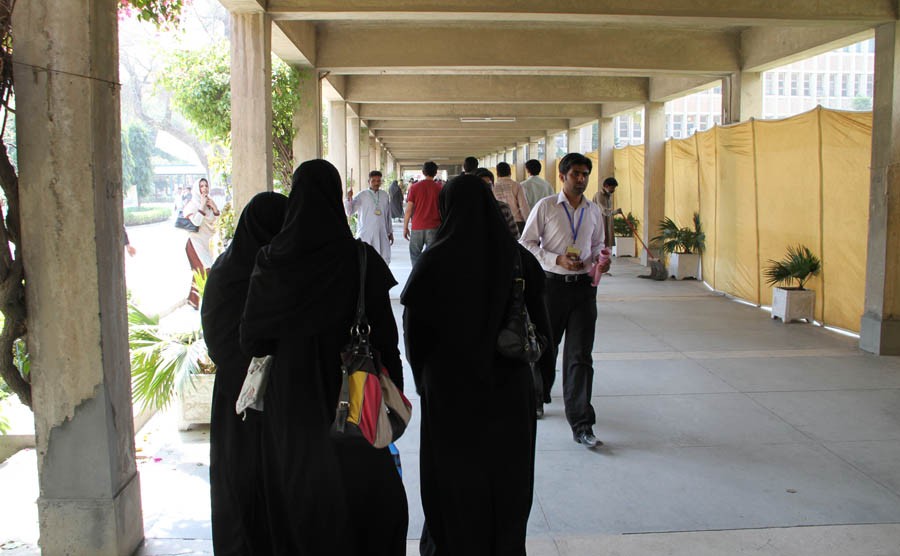
It’s unthinkable how different cultures operate in one single university, especially with regards to mingling of the two genders

If you are a university student in Punjab, especially in the public sector, there is a chance you have seen, heard about or read a book comprising love letters of two students of the Punjab University. Jhootey Roop Ke Darshan was like a bible at least for the students of 1980s and ’90s. Apart from being the quintessential love story that humanised that institution, it captured the zeitgeist of the 1970s. The political battles being fought and the moral choices available to students of the Punjab University were a far cry from the barren place it had turned into by the ’80s.
The domineering role of one student wing that gained full might during Ziaul Haq’s time had changed the complexion of the University. Jhootey Roop, therefore, came as a shock to students making them wonder about such rapid transformation of the institution and for the worse.
The worst part of the deal was reserved for women, who were supposed to exist as separate beings in an institution that was mixed-gender in theory. The moral policing brigade ensured the institution became effectively segregated; the collusion between the teachers and students belonging to one political group came in handy for that.
A visit to the University as a woman in say the 1990s left you with an uncomfortable feeling, of being watched by unseen prying eyes, conscious of what you wore and who you talked to. You wanted to get out of the place as soon as possible. For the students who were used to the environment, it would have been different.
Read also: Academic standing
The Punjab University today seems like a different place if you happen to be in a certain cluster of departments, where women are free to wear what they like, mingle with male students and discuss and work together. At the English department, which always remained an island of sorts, the world poetry day was being celebrated and poems on freedom recited the very day there was a clash between two groups in another part of the campus. The girls and boys at the Mass Communications department sit together in the cafeteria while there is a small separate area reserved for girls too. Inside the department is another world; the teachers make sure the group work is mixed-gender and there is healthy interaction between them. Likewise for Psychology, IBA and a few others.
It’s amazing how quickly this changes if you step into Hailey College almost next to this cluster of departments. Nobody knows when and how it started but inside one building, there are separate classes held for girls and boys. A popular department with hundreds of students, someone deemed it fit to put the girls and boys in separate compartments to teach them. No boy is supposed to talk to a girl or vice versa.
There is an unwritten dress code. The women ought to wear a proper shalwar kameez and dupatta while jeans is out of question even for boys. The boys can only wear formal clothes but no jeans.
I ask a former student about the dress code and she tells me it’s not exactly unwritten, "it’s there on the notice board". She also tells me no students of a particular group visibly impose these codes. "They do it through the administration. It’s all done in the administration’s name". Did she expect segregated classes when she got admission here, I ask. "No, I didn’t. Most girls and boys don’t know this at the time of admission. Some students are not happy with this but the girl students do feel more secure and satisfied this way," she says. More than half of her classfellows did purdah and "half of them did sharai purdah".
It’s unthinkable how different cultures operate in one single university. Perceptions thrive.
One perception is that the Islamic Studies Department has segregated classrooms with a partition separates the girl students from the male teacher. There was no time to ascertain this but at the Punjab University everything seems plausible.
Another student divulged there was an award reserved for Hailey College by an international body but it was refused when they came to know about the segregated teaching within this college. "They said you are refusing exposure to the girl students. How will they gain confidence to work at places like banks?"
You land in another culture as you move to the main Faisal Auditorium where many social and pure sciences departments are.
There is a big cafeteria for women while another one for men lies on the other end of the road. At 2 o’clock in the afternoon, the women’s café is packed and all you can see is abayas all around. They are being served by two men but the girls take them in their stride. These are Bachelors, Masters and PhD students, many of whom have either internalised the segregation or it seems like a carryover from their world outside.
The girls here are happy with the university environment which is ‘comfortable’, ‘secure’, ‘cooperative’. Why come to a separate canteen for girls when they study with boys? "It is very helpful for girls with veils. They can sit here and eat comfortably". A group of Bachelor students seemed too wary of the fights in the University. "That day, when there was a scuffle between the IJT and Pashtun students, we were confined to our classrooms. This worried our families too much."
Punjab University addresses and reinforces the insecurities of women in this society instead of opening their minds that an institute of higher learning is supposed to do. It is for the University to think if it wants to stick to this ‘comfort zone’ image or not.